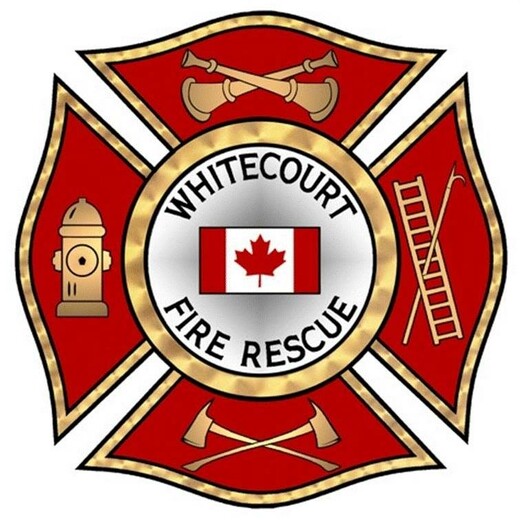
Follow the Whitecourt Fire Department on Facebook.
Whitecourt Fire Department
“With pride and professionalism, we provide emergency services and education to Whitecourt and surrounding area.”
The Whitecourt Fire Department consists of a full-time Fire Chief, a Deputy Chief, a Training Officer, a Fire Department Clerk; and, up to 42 paid, on-call Firefighters. The Department provides fire protection and rescue services for the Town of Whitecourt and the surrounding areas of Woodlands County. Contact the Fire Department between 8:30 a.m. and 4:30 p.m. Monday through Friday (except for statutory holidays) at:
Whitecourt Fire Department
5205 51 Street, Box 509
Whitecourt AB T7S 1N6
Phone: 780-778-2342
Email: firedepartment@whitecourt.ca
For Emergencies call 911.
Firefighters:
- Respond to emergency calls – fire, medical and other.
- Drive and operate vehicles and equipment.
- Provide emergency medical response and aid – rescue and extrication.
- Perform duties in fire prevention and public education.
- Participate in department training with respect to emergency equipment and emergency procedures.
- Participate in public relation projects (such as recruitment, demonstrations, visits, etc.).
Fire Services Bylaw 1582
The Fire Services Bylaw includes legislation for residential fire pits and fire permits; includes updated provisions for fire restrictions and fire bans; and, includes fees and charges for services provided by the Whitecourt Fire Department, including fire inspections, fire investigations and incident responses.
Volunteer Firefighter Recruitment
Qualifications:
- Minimum 18 years of age
- High School Diploma or Equivalent
- Criminal background & vulnerable sector screening satisfactory to the Town of Whitecourt
- Valid Alberta Class 5 Driver’s License (Class 3 with air brakes would be considered an asset)
- Driver’s abstract with 7 or less demerits
- Ability to understand and communicate fluently in English
- Physically fit and able to obtain medical clearance to perform tasks/duties of the job (See Summary of Physical Demands)
- Able to commit to training and respond to emergency calls
- Live within the response area
Attributes:
- Positive attitude driven by strong values and ethics
- Motivated with well-developed interpersonal and team skills
- Good mechanical aptitude and problem solving skills
- Willingness to learn and a commitment to excellence
- Ability to effectively operate under the realities of emergency situations
Summary of Physical Demands:
This position will include activities that include, but are not limited to, structural firefighting, pre-hospital patient care, rescue and extrication, confined space and wild-land firefighting. Some of the major stressors involved in training and day to day operations are outlined below:
- Tolerating extreme fluctuations in temperature while performing duties. Firefighters are required to perform physically demanding work in hot (up to 150ºC or 400ºF), humid (up to 100%) atmospheres while wearing personal protective equipment that significantly impairs thermoregulation. (Core body temperatures can reach up to 40ºC after 20 min of hard work).
- Wearing firefighting clothing and equipment that weighs at least 22 kg (50 lbs.) while performing firefighting work.
- Sustaining body positions for extended periods of time while operating equipment or providing emergency medical assistance. This may include using tools or working above their head.
- Performing physically demanding work while wearing positive pressure self-contained breathing apparatus (SCBA) which presents a significant resistance to expiratory flow and may reduce peak exercise ventilation by approximately 15%.
- Making rapid transitions from rest to near maximal exertion without warm-up periods.
- Operating in environments of high noise, poor visibility, uneven terrain, slippery surfaces and limited mobility; at heights; and, in enclosed or confined spaces.
- High levels of cardiovascular stress as evidenced by average heart rates of 70% of the age-predicted maximum during training scenarios with brief, repeated periods of near maximal heart rate (90+%).
Whitecourt Fire Department Volunteer Application Form
The personal information collected through the Whitecourt Fire Department Volunteer Application Form is for the purpose of processing applications, including eligibility, review, and communication of decisions. This collection is authorized per section 4(c) of the Protection of Privacy Act. For questions about the collection of personal information, contact the Town of Whitecourt Administration Office at administration@whitecourt.ca or 780-778-2273.
